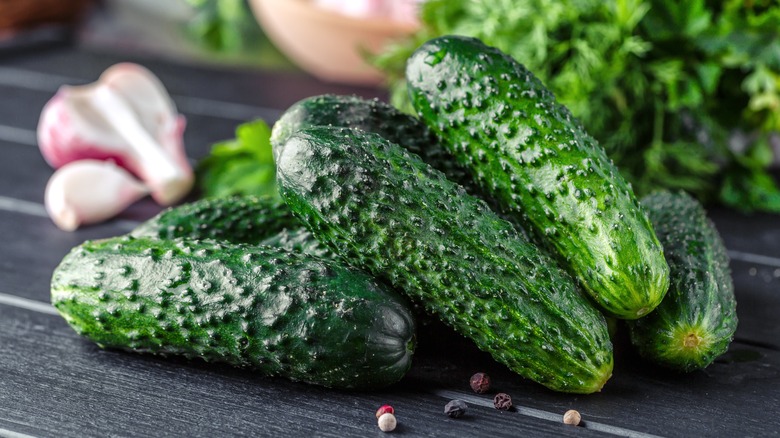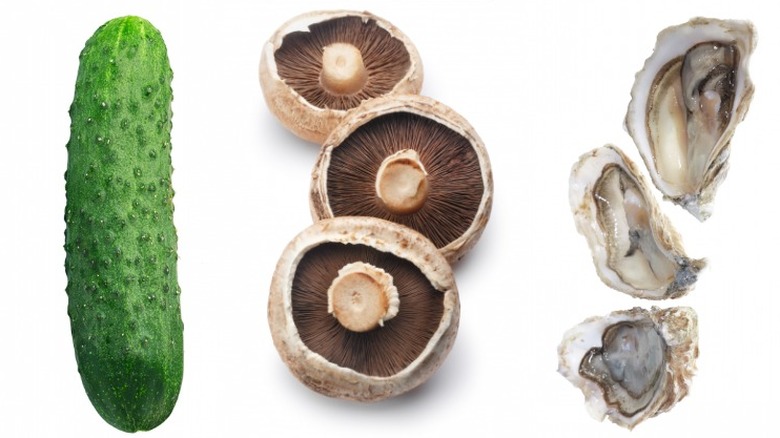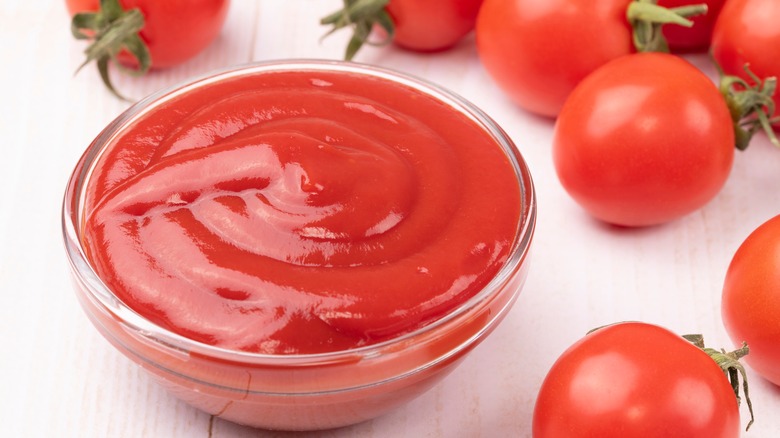The Bright Green Cucumber Sauce That Predates Tomato Ketchup
Finding cucumber ketchup on a menu might raise some eyebrows. After all, why mess with a good thing? Ketchup is a classic for a reason, right? Well, it might surprise you to learn that cucumber ketchup, far from being a radical reimagining of the standard, was around well before tomato ketchup became the norm. In fact, cucumber and tomato represent just a fraction of the many ketchup varieties out there, and if it weren't for a little company called Heinz, we might have had a better understanding of the full ketchup spectrum. Instead, we (particularly in the United States) tend to think of the condiment as a singular thing defined largely by the presence of tomato, ignoring the fact that, in the wide world of ketchup, almost anything goes.
Many historic British and American cookbooks contain recipes for cucumber ketchup, but they vary greatly from one to the next. The basics are consistent: Take chopped or grated cucumbers and bring them to a boil along with onions, vinegar, and various spices before lowering the heat and simmering to produce a viscous sauce. The ingredients are really a free-for-all, with recipes calling for everything from mustard seed to nutmeg to horseradish in order to round out the flavor. You'll need to find a recipe whose ingredients suit your palate and try making it on your own. Now, if you're wondering why you don't see cucumber ketchup in grocery stores these days, we need to look back at history.
Ketchup used to come in many varieties
Ketchup may seem like the epitome of American eating, but it actually originated in Southeast Asia, and the word "ketchup" comes from the Hokkien Chinese "kê-tsiap" or "kôechiap," which refers to a fermented fish sauce popular in Fujian Province. Similar products were also made from vegetables, beans, and meats, and they eventually spread throughout Southeast Asia via trade routes. In the 17th century, traveling Dutch and English sailors discovered kê-tsiap, bringing it back to Europe. In 1727, an English cookbook author named Eliza Smith published the first known recipe for ketchup, which included anchovies, vinegar, and mustard powder. By the 1740s, ketchup had become a ubiquitous condiment in British homes, but it had a very loose definition, referring to any spiced sauce.
Ketchup steadily gained popularity in the West throughout the late 1700s and early 1800s. Home cooks were making their own versions of the sauce out of whatever they had on hand. Oysters and mushrooms were popular bases, but so was all manner of produce. Plums, peaches, berries, celery, and yes, indeed, cucumbers all showed up in cookbooks of that era. You can even find recipes for walnut ketchup, reportedly a favorite of Jane Austen. Not only were these sauces delicious, but they also served a practical purpose. Blending fish or vegetables with salt and vinegar helped preserve them for long-term storage in the days before refrigeration.
Tomatoes pushed cucumbers out of the ketchup world
So what happened to cucumber ketchup, not to mention all those other varieties? The answer lies in the steady industrialization of the culinary world. Back when homemade ketchup was the standard, people were more flexible with ingredients. Though that changed in the 1800s, there is some contention over when tomato ketchup was first invented. Credit is typically given to a Philadelphia-based horticulturalist named James Mease, who published a recipe for tomato "catsup" in 1812, referring to the fruit by the adorable antiquated nickname "love apple." However, a cookbook manuscript written by a Mrs. Michel of Cooperstown, New York, around 1795 was also found to contain a tomato ketchup recipe, indicating that, while Mease may have popularized the variation, he wasn't the first to think of it.
The biggest shift in the ketchup world came a few decades after Mease's recipe was published. In 1876, the up-and-coming H.J. Heinz Company released its famous tomato ketchup, and in 1882, founder Henry Heinz patented the famous bottle that you can still find on every diner table in America. The convenient nature of store-bought ketchup proved irresistible, and by 1908, sales of Heinz hit $2.5 million — a truly stunning profit for that day and age.
Although the popularity of Heinz bottled ketchup and the many brands that have followed it gradually pushed cucumbers, mushrooms, fish, and the many other ingredients once found in ketchup out the door, you can still make your own cucumber ketchup. Lighter and less cloyingly sweet than the tomato variety we're all used to, it pairs beautifully with fish.


